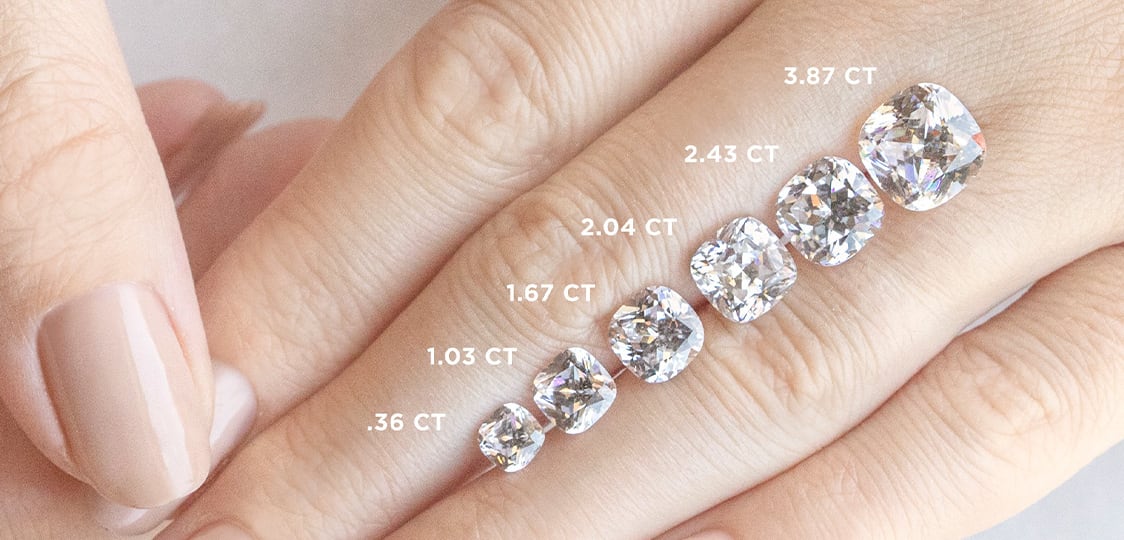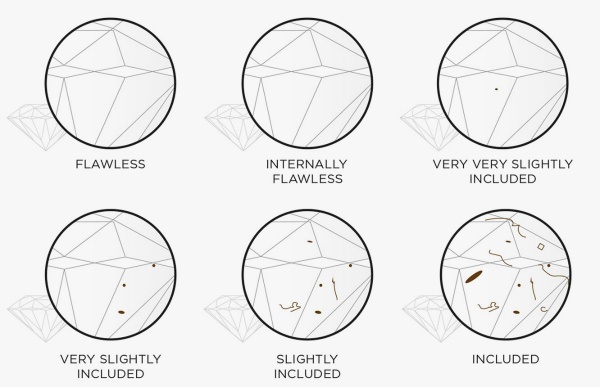Did you know there are over 20 000 possible combinations of the basic diamond specifications: colour, shape, clarity and cut?
It can be overwhelming.
But it doesn’t have to be.
This blog is a great starting point.
The 4C model is a great starting point to help you in understanding the most important characteristics, and how they affect the appearance, quality and price of any diamond.
It’s crisp and straightforward and will get you well on your way to making a well-informed diamond engagement ring buying decision.
These 4 Characteristics are;
- Carat
- Colour
- Clarity
- Cut-Grade
There are a handful of differences that are worth noting when you’re weighing up mined diamonds to laboratory-made.
The winner?
Trickier than you would imagine.
What are laboratory-made diamonds?
Until recently, Mother Earth had sole rights to the creation of diamonds.
She takes her time over a few million years to bake them in the Earth’s crust under immense pressure and heat. When ready; they’re mined, cut into polished gemstones, and masterfully set into high-end engagement rings and all sorts of coveted jewellery items.
And then, as if an Alchemist’s prayers were answered, a process to make real diamonds in a laboratory was discovered.
Using the same ingredients as Mother Earth, laboratories can mimic and greatly expedite the natural diamond formation process from millions of years to months.
This process yields true and real diamonds with their characteristic crystal structure, sparkle, fire and durability.
Demand for them is growing by the day for many reasons. Since they;
- Share the identical molecular structure and composition of natural diamonds.
- Are visually indistinguishable from naturally formed diamonds.
- Cost at least 60% less than a similar natural diamond.
- Are independently graded by leading diamond grading laboratories including the venerable GIA.
- Are real diamonds and, as expected, test as such on digital diamond testers.
The C’s
Carat – Weight.
Carat is simply a measure of weight, like kilogram and pounds, used in the jewellery industry.

It’s as simple as – 1,00 Gram = 5,00 ct (carats).
As the weight of a diamond increases, its price spikes parabolically.
The next chart shows the parabolic increase in diamond prices as the weight doubles, while other specifications are locked in place at G-colour VS1-clarity for this example.
Shape | Weight | Colour | Clarity | Price |
Round Brilliant | 0.50ct | G | VS1 | $1,330.00 |
| Round Brilliant | 1.00ct | G | VS1 | $6,160.00 |
| Round Brilliant | 2.00ct | G | VS1 | $22,400.00 |
*A doubling of weight quadruples the price.
Importance of weight
There’s no way around it. Close to every single diamond engagement ring design ever imagined looks better with a larger diamond.
It matters.
That’s why most of the diamond ring designs you find online and in print advertising are displayed with a beyond average size centre diamond to make the design look as impressive as possible.
Laboratory-made diamonds should cost around a third of a similar specification natural diamond. This significantly lower floor price makes larger diamonds accessible across the board.
That’s a major draw for an ever-growing slice of the laboratory-grown diamond jewellery market.
For any given budget you can significantly increase the size without breaking the bank when opting for a lab-grown diamond.
We’re talking up to a 50% increase in size.
Second C: Colour.
A diamond’s colour grade indicates how white or yellow a diamond is.
Using the common alphabet the colour range starts at D which is perfectly colourless, and tinkers down to Z which is prominently yellow or brown.
As you move from one letter to the next the prominence and of the colour tint very slightly intensifies.

Although not as dramatic as carat; the higher the colour, the rarer the diamond and the steeper the price.
When diamonds are made in a laboratory, the colour can be controlled to a certain extent, and as you would expect, laboratories focus on creating high-end, striking white diamonds.
The bulk of laboratory-made diamonds sold in the jewellery market are desirable top tier colours typically in the D – E – F – G – H colour range.
That’s without a doubt whiter than your average run of the mill natural diamond colours you find in engagement rings.
Should you prefer warmer colour diamonds in the J-K-L range; there are laboratory-made options available.
They’re just oddly enough a bit harder to find than pinnacle colours like D – E – F!
Third C: Cut (Regardless of size, this is the most important C)
Diamond cut is often confused with the diamond shape (Round, oval, square). You’ll find some jewellers that don’t even know the difference.
But at least you do.
The Cut grade refers to how well a diamond was cut and polished from uncut/rough to maximise its characteristic life, sparkle and brilliance.
A diamond has very special light reflection and refraction characteristics. You can think of a diamond’s facets (sides) as internal mirrors that reflect light internally to and from the diamond’s environment.

To optimise this light show – the ideal angles, dimensions, proportions of every facet has been determined. During grading a diamond is 3D scanned and compared to this benchmark range of values.
If the diamond has been poorly made the size, clarity and colour don’t matter… You’re stuck with what looks like a dull piece of glass.
In the world of naturally formed diamonds, the GIA is the benchmark of truthful, consistent third-party diamond grading. They developed a now popular 5 tier scale to grade a diamond’s cut grade;
- Excellent: Optimal light reflection and refraction.
- Very Good: Very close to perfect – mostly indistinguishable from Excellent cut unless you know your diamond very well.
- Good: Some look nice, most don’t. Not recommended.
- Fair: Not recommended.
- Poor: Not recommended.
Currently, the vast majority of laboratory-made diamonds are graded by the IGI which does a great job but uses a slightly different cut grading system.
I don’t think it’s more than linguistics in an effort to differentiate themselves.
Where GIA’s top cut tier is Excellent, the IGI adds a tier above that called “Ideal”.
In my opinion, it’s not superior to the Excellent cut as defined and issued by the GIA.
Whether you opt for GIA’s Excellent, or IGI’s Excellent or Ideal cut – you’re buying the cream of the crop.
Fourth C: Clarity
The clarity grade is a measure of the pureness of a diamond.
Both natural and laboratory-made diamonds do have certain inclusions/imperfections in them.
Inclusions vary greatly in type, severity, colour and location.
These range from benign minuscule white spots to cracks that severely compromise the strength of a diamond. And everything in between.
These inclusions leave every diamond with its own unique fingerprint.
The clarity grade is determined by a gemologist viewing and judging the type and amount of inclusions visible in a diamond at 10X magnification.
They’re not graded by the naked eye and often these inclusions are impossible to spot without magnification.

After inspection the gemologist issues a clarity grade based on what they saw;
- Internally Flawless: No visible Impurities under 10X magnification
- VVS: Very, very small inclusions barely visible under 10X magnification
- VS: Very small inclusions visible under 10X magnification.
- SI: Small inclusions that might be visible to the naked eye.
- I: Very obviously included to the naked eye.
Eye-clean is all you need.
87% of women polled have a strong preference for diamonds free from any visible inclusions to the naked eye.
That doesn’t mean the diamond should be internally flawless.
Without magnification VS2-clarity and higher is usually flawless to the naked eye and all you need to ensure your laboratory-grown engagement ring is absolutely blemish-free.
Rather increase the size of your main diamond than max out clarities beyond what your eye can see.
*For sizes over 2,00ct, VVS2 and higher might be the safer bet.
As with colour, diamond growing laboratories focus on creating diamonds that are at the upper end of the clarity grading scale and the vast majority are of higher clarity than the vast amount of natural diamonds you’ll find on the market and jewellery circuit.
Sounds Interesting?
Reaction to the laboratory-grown diamonds on display has been incredibly positive.
More than a few couples have decided to opt for a larger lab-grown diamond over a mined diamond.
I’m not recommending one over the other.
What I strongly recommend though is that you at least come and take a good look! A laboratory grown diamond might be the perfect fit for your dream engagement ring.
You can reach my studios here;
Rosebank: (010) 020 6811 and melissadp@poggenpoel.com
Pretoria: (012) 111 0525 or info@poggenpoel.com
Thank you for reading. Feel free to reach out to me directly at johan@poggenpoel.com with any questions.
I’m here to help.
Take care.
Johan Poggenpoel
Co-Founder.
